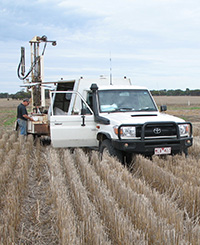
 Background
Background Building on the now-completed Victorian soil carbon project, this study addressed uncertainty about how farm management practices can increase soil carbon.
Researchers determined the effectiveness of a range of management practices for increasing soil carbon in cropping and pasture systems across eastern
This project was a joint undertaking between Department of Economic Development, Jobs, Transport and Resources Victoria, Rural Climate Solutions (NSW DPI / University of New England) and the Department of Science, Information Technology, Innovation and the Arts Queensland. Each state project involves collaboration with the leading regional industry groups.
The research assessed practices that previous research or farmer experience suggest may have the potential to sequester carbon, including pastures in crop rotations, alternative residue management and alternative grazing systems.
Researchers also investigated the interactions between carbon and nitrogen in the soil-plant system to understand how soil carbon sequestration, greenhouse gas emissions and productivity are linked to nitrogen, soil type and climate.
Soil carbon was measured in farm paddocks and field trials and the data used to validate simulation models, so that experimental findings could be extended across eastern
Analysis of data collected from almost 1500 field sites across Queensland, New South Wales and Victoria showed that land use and management practices had relatively small influences on soil carbon. Climate and soil properties had considerably more impact.
Field experiments assessed practices that previous research or farmer experience indicated may impact soil carbon storage. Findings included:
Scenario analysis using the APSIM model allowed researchers to extrapolate field data and observations across eastern Australia. For example, long-term modelling showed that continuous cropping with stubble burning consistently resulted in soil carbon decline, whilst stubble incorporation and nitrogen application under cropping generally increased carbon or reduced the declines.
With its wide-ranging study of the effect of management practices on carbon stocks, this project will now allow farmers and policymakers to make more informed decisions about soil carbon management.
| Title | Excerpt |
|---|---|
| Soil carbon publications | A bibliographic survey of research publications produced by the soil carbon project. |